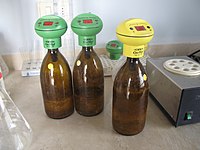
Photo from wikipedia
Discharging excessive pollution into rivers that exceeds their self-purification capacity decreases the quality of water and threatens the aquatic ecosystem. In such water systems, polluters and environmental protection agencies are… Click to show full abstract
Discharging excessive pollution into rivers that exceeds their self-purification capacity decreases the quality of water and threatens the aquatic ecosystem. In such water systems, polluters and environmental protection agencies are involved parties that often have opposite interests. This research proposes a method to enhance the water quality of rivers while satisfying the interests of both parties. It allocates waste loads to polluters and requires them to pay the treatment cost in order to remove pollution. The proposed methodology employs a combination of QUAL2Kw and non-dominated sorting genetic algorithm-II to minimize wastewater treatment costs and dissolved oxygen violation from the standard level. The river inflow uncertainty is considered by Latin hypercube sampling to give more real insights to decision makers through a stochastic approach. As a result, the Pareto sets act as strategies that can be used to meet the objectives, but they show the contradiction between parties’ interests. According to the waste load criterion, this methodology reduces waste load from 145.5 to 79, 107.15 and 115 units for dry, normal and wet months. Also, it decreases treatment cost from the range of [160,000–180,000 $] to [100,000–130,000 $] considering the water quality and dischargers’ interest. According to the results, considering river inflow uncertainty can increase the concentration of dissolved oxygen even more than the standard level, and point sources treat their wastewater more than non-point ones. Generally, it is a suitable tool to find solutions for minimizing the treatment cost in favor of dischargers and improving water quality.
Journal Title: International Journal of Environmental Science and Technology
Year Published: 2020
Link to full text (if available)
Share on Social Media: Sign Up to like & get
recommendations!